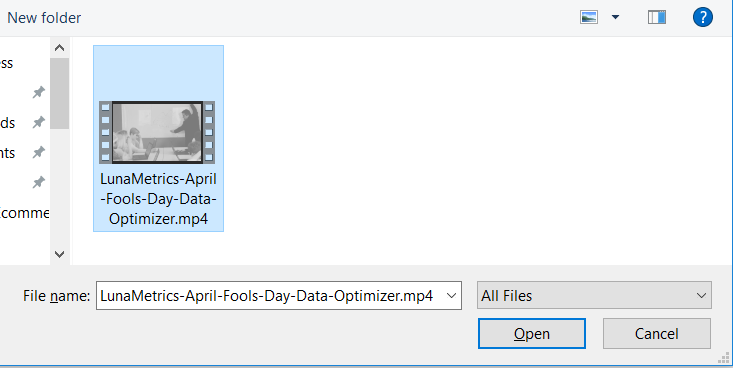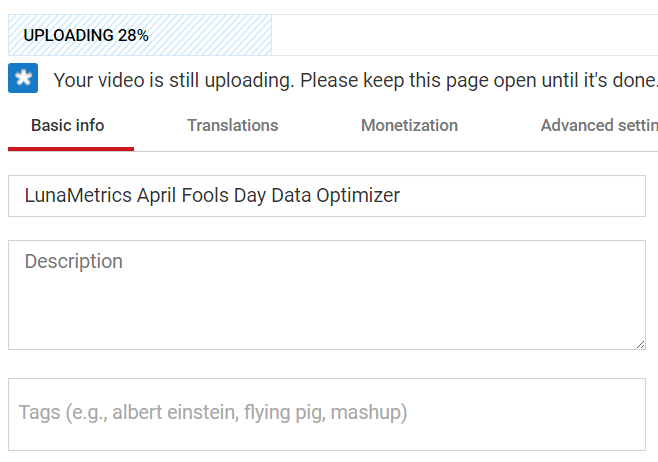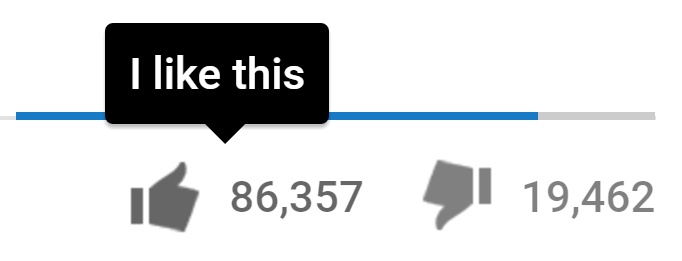How To Boost Your Video Rankings On YouTube And Google Search
YouTube is the second largest search engine on the internet and is owned by the world’s largest search engine: Google. Videos posted to this massive social network appear on social media feeds, are embedded into web pages and even serve in Google search results. The social network even provides its own comprehensive Analytics dashboard to help channel owners determine the value of their content. With so many perks, it’s no wonder people choose to post their videos on YouTube versus other platforms like Vimeo or Vine.
Before diving in head first, let’s discuss how we can work smarter, not harder. Understanding YouTube’s priorities and best practices will help you create a channel with greater potential to rank in YouTube and in Google search results.
Invisible Ranking Factors

Video Filename
The name of your video (the file name) is an object YouTube uses to distinguish the video content so that it may be shared in the most relevant search results. Make the file name relevant to the video and include your key search terms.
Best Practices:
- Use a descriptive video filename
- Use hyphens between words in the file name
Meta Tags
Meta tags are widely accepted as one of YouTube’s top 3 ranking factors, so it’s important to choose them wisely. Pick keywords that describe your video and are frequently searched on the platform.
YouTube videos are instantly indexed, but bots can’t understand the video content. By providing meta tags, channel owners provide a way for bots to interpret what the video is about.
When you upload a video to YouTube, you’ll be prompted to tag the file with your keywords. 10 or less tags are ideal.
Best Practices:
- Research keywords before tagging your video
- Use relevant tags
- 10 or less keywords per video
- DO NOT use the same keywords you used in your title and description. Tag-stuffing can get your video removed
Watch Time
Watch time, the amount of time in aggregate that your viewers are watching your videos, is YouTube’s top ranking factor. If people aren’t watching your videos for any length of time, then your video isn’t going to rank well. However, if you make videos that people are watching well beyond the first click, those videos will be suggested more frequently.
You can see which videos have the best view times and view-through rates in your Views Report in the Analytics section.
Best Practices:
- Create descriptive and emotional video thumbnails
- Provide a compelling intro
- Build up interest throughout the video with programming, branding, and packaging techniques
- Use annotations in the video and links in the description to encourage users to view more content
- Encourage comments and participation to get users involved and to keep them interested
- Feature content on your channel page
- Keep an eye on your View and Audience reports to determine which videos are successful
Flags/Reports
Flags and reports are both considered when ranking your videos. YouTube allows users to flag and report videos. They also have an internal team who review and remove videos that don’t comply with their community guidelines. If videos do not violate the guidelines, they will not be removed regardless of the amount of flags/reports submitted.
“Flagged videos are not automatically taken down by the flagging system. If a video doesn’t violate our guidelines, no amount of flagging will change that, and the video will stay on the site.”
Best Practices:
- Follow the Community Guidelines
- If you feel that your video was wrongly flagged, appeal the removal.
Visible Ranking Factors

Title
Adding context to your video is important, and one way to do that is through titles. YouTube’s maximum character limit is 100 characters.
Providing a descriptive title helps users find and decide whether they want to watch your video. This is an opportunity for channel owners to describe videos and include keywords for better visibility.
Remember that the video has to deliver on the title’s promise. If users are disappointed, they won’t favorite, add to playlists or share, which are all important factors in the videos visibility.
Best Practices:
- Write a descriptive, relevant title
- Use keywords
- Limit titles to 100 characters
- Keep keywords towards the front of your title for better SEO value
Description
Video descriptions are a great opportunity to provide context: who, what, when, where and why. These descriptors can help to engage the user, help people find you in the search function and potentially drive conversions.
The platform provides 5,000 characters for you to describe your video. Keep in mind that the first 150ish characters are the only text in the description that are visible to the user when they land on your video.
YouTube and Google search results provide a shorter snippet of your description at about 120 characters.
Best Practices:
- Include keywords
- Be aware of the first 157 characters
- Describe the video without giving away too much information
- Provide a clear CTA link to on-site content
Transcripts, Subtitles and Captions
To provide a better user experience and more information to YouTube bots, include manual word-for-word transcripts and/or subtitles. This is a chance to engage users, especially those who are hard of hearing.
Best Practices:
- Manual, word-for-word transcriptions ensure accuracy
- Transcript file needs to be in the same language that is spoken in the video
Channel Branding and Authority
When people come to your channel, they should immediately recognize the connection between your channel and your branding. Channel name, icon, banner and vanity URL (if you meet the requirements) should clearly reflect your brand.
You have control over your content—publishing frequency, title, description,tag relevance, optimization and promotion. Use that control to build an engaged subscriber base. As it increases your channel will become more authoritative and your videos more searchable.
Best Practices:
- Your channel name, icon, banner (aka “Art”) and vanity URL should reflect your brand
- Fill in the channel keywords and targeting
- Fill in your website for the Associated Website field
- Fill in the channel description and social links
- Utilize the featured video option to share important information with users
- Create a branded intro and outro
- Build an engaged subscriber base
Quality
Ensure that all videos uploaded to your YouTube channel are high-quality, like HD video. YouTube and Google prefer HD and rank it high because it provides a better user experience.
It’s easier for a channel to rank if they consistently produce well-made, engaging videos. If users dislike the condition of the video, they will not like, comment on or share it, which can make it more difficult for the video to rank.
Best Practices:
- Make sure that you focused on delivering the best content possible (preferably in HD)
- Ensure audio is comprehensive
- The picture should be clear, not blurry or out of focus
Engagement
Engagement is a key ranking factor. Likes, dislikes, comments and shares show YouTube whether the community enjoys your content. The more engaged users are, the higher your video will rank.

Likes are great engagement factors. The more likes you get, the more likely people are to watch your videos. In addition, the liked video gets added to a playlist so they are able to return to it quickly when they want to watch it again. Likes are also used to help YouTube recommend videos to users in the sidebar or when the video ends.
Dislikes are not a death sentence. They still count towards engagement, which help to rank your videos.
Comments are also important for rankings. First, they are a form of engagement, showing YouTube that the video was worth interacting with. This is especially helpful if comments are made regularly because it increases the freshness of the page. Second, comments typically discuss the video, which adds keywords and context to the page. This can help search engines understand the content better.
Remember to moderate your comments. Take the time to respond to comments, whether they are positive or negative. This helps to build a community. You can report or hide comments that are inappropriate or spammy.
You can also track when, how and where someone interacts with videos on your landing pages. We’ve developed a script which is a plug-and-play tracking solution (via Google Tag Manager) for tracking user interaction. All you have to do is download the script, import it into GTM and update the GA tracking ID with your own.
Best Practices:
- Use any and all channels to get people to watch your videos
- Measure views/engagement with Analytics
- Promote the video and moderate comments to ensure quality and recency of engagement
- Do not artificially manufacture responses, but rely on natural user behavior
- Respond to people who are commenting
- Build these interactions into a social following
Inbound Links and Embeds
Links are one of the top ranking factors in Google organic search. They act as a vote of confidence for the page they’re directed toward, which lets Google know the page is important or entertaining.
Just like Google, YouTube uses links to determine whether a video was enjoyed by users. Getting links to your video improves the likelihood that someone will watch it and potentially engage with it.
When other websites embed your videos, it helps tremendously with rankings. Embeds are like backlinks, but stronger. People are not only linking to your content, they’re displaying it right on the page. This passes link authority and helps to improve that video’s ranking on YouTube/SERPs.
Embeds on your own website are helpful in getting views and engagement. However, the backlink signal is not very strong because YouTube and Google both know that your channel and website belong to the same organization.
Best Practices:
- Utilize any and all marketing and PR channels to build links to the channel and videos
- Focus on your best content because it will naturally attract links
- Links from colleges and universities (.edu links) will be your most authoritative opportunities
- Always think about how to build links – all social profiles, email footers, press releases, website embeds, etc.
- Embed videos on your site or blog to build up views and engagement
- Measure engagement with videos on your site through Google Analytics to understand which sections of the site are making the biggest impact
Social Shares
Whether users are on your website or your channel, they’re already digging through your content, which means you’re dealing with an already-engaged audience. Use that opportunity to encourage them to share your work.
There are many ways to use social media to promote user sharing/viewing.
- Add share buttons to your website so that people can share your videos on their social network of choice.
- On your YouTube channel, make sure you fill out links to your social accounts. This way, users can follow you on more than one social network, which increases the probability of them seeing your videos.
Best Practices:
- Set up social buttons on your website to make it easy for users to share across networks
- Fill out your social networks in the appropriate fields in your YouTube profile
- Encourage your followers to share your content


